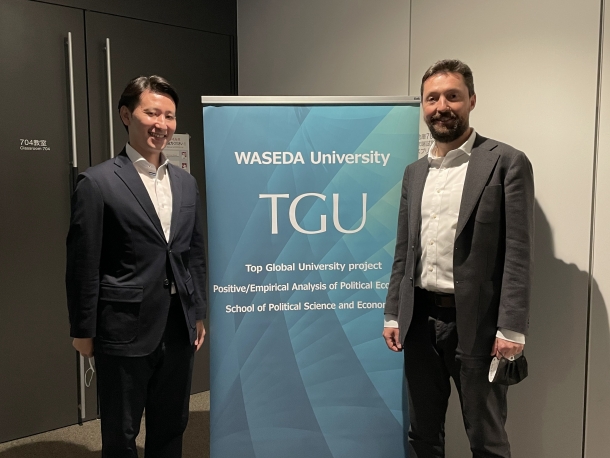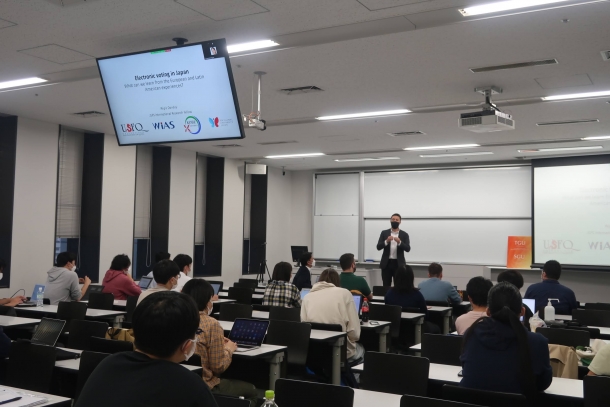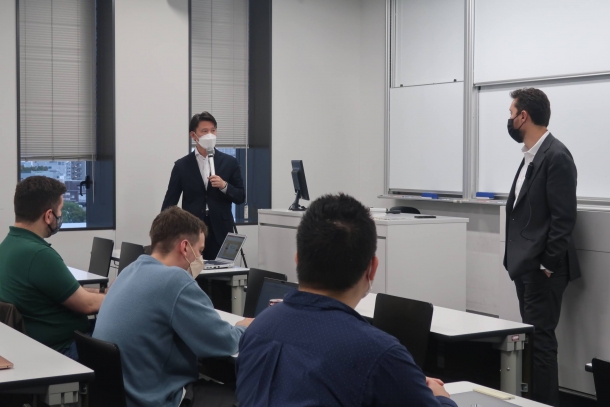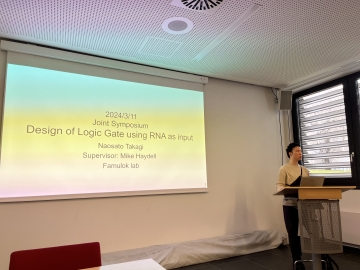SGU実証政治経済学拠点は高等研究所との共同開催によりサン・フランシスコ・デ・キト大学レジス・ダンドワ教授をお招きし、「Electronic voting in Japan. What can we learn from the European and Latin American experiences? 」と題して、電子投票に関する最新の研究成果についてセミナーを開催しました。


ダンドワ教授はベルギーの政治学者です。エクアドルの サン・フランシスコ・デ・キト大学(USFQ, Ecuador)で教鞭を取る一方、早稲田大学高等研究所の招聘研究員としても精力的に活動されています。また、ベルギーのブリュッセル自由大学の訪問研究員、特別講師、The United Nations University Institute on Comparative Regional Integration Studies (UNU-CRIS)のアソシエイツリサーチフェロー等、幅広く活躍されています。
さらに、電子投票に関する専門家としてエクアドルやベルギーの選挙関連の行政機関に協力してきた経験を持ち、様々な国での選挙監視の豊富な経験を持つ気鋭の研究者です。
日野教授によるダンドワ教授ご紹介に続き、セミナーでは電子投票が投票率、無効票、分割投票にどのような影響をもたらすかについて、日本の事例やヨーロッパ諸国、ラテンアメリカ諸国の経験から検討が重ねられました。電子投票によって必ずしも投票率が高まるわけではないが、日本では投票率が高くなる傾向にあるとの知見が報告されました。このセミナーには30名近い学生や若手研究者が参加し、Q&Aでは学生からの「電子投票システムの使いやすさの違いによって影響の出方が各国で異なるのではないか」という問いに対して、多くの政党が選挙に参加する国では一つの画面に政党のリストを表示することができないため、トップページに表示されなかった政党の得票率が電子投票を行わなかった自治体と比べて低くなったという実際の事例を紹介する等、熱心な質疑応答が続き、参加者が多くの示唆と学びを得るセミナーとなりました。

参加学生のコメント(英語のみ):Robert Nordström 政治学研究科博士後期課程4年
I`m a doctoral student at Waseda University Graduate School of Political Science. My research interests lie in Japanese local elections and how electoral competition is correlated to the quality of democracy. These were my thoughts on the lecture “Electronic voting on Japan: What we can learn from the European and Latin American experiences” by Professor Regis Dandoy.
The presentation focused on the challenges posed by electronic voting or E-voting, and professor Dandoy`s insight as an expert with real-world experience in helping governments implement E-voting made meant that the findings were so much more insightful. In the presentation, professor Dandoy discussed how the introduction of E-voting influences voter turnout, the number of invalid votes and split voting. He also discussed how E-voting influences voters of different age-groups, gender, and backgrounds. To showcase his theories, Professor Dandoy provided evidence from E-voting systems in Japan, Europe, and Latin American countries.
In the first part of the presentation, professor Dandoy showed the impact E-voting has had on voter turnout. While the common expectation would be that E-voting should have a positive effect on voter turnout, professor Dandoy showed that E-voting in fact has led to fewer voters participating in elections in many countries. By using the concept of usability, professor Dandoy argued that while E-voting is meant to make it easier to vote, it is often poorly implemented making it more difficult for voters to cast their vote then using paper ballots. The lack of usability in E-voting was showcased by showing an example of a mock election in Belgium online where voters had to press dozens of buttons to be able to register their votes. This lack of usability, he argued, often lead to many voters not willing to participate in the democratic process. Further, if the technology of E-voting is difficult to use it may also lead to people failing to register their votes or even voting for the wrong candidate by mistake. Therefore, rather than improve usability, introduction of E-voting in many cases makes it harder for voters to cast their vote. It was also argued voters might be apprehensive regarding using new technologies overall. Professor Dandoy showed evidence for this theory by showing that E-voting had led to a drop in voter turnout in Belgium and Ecuador.
This is a very interesting finding as it shows that introduction of new technologies into our political systems might not always be positive. However, in a very interesting twist, professor Dandoy found that only in Japan did E-voting lead to increased voter turnout. This begs the question, why does E-voting lead to an increase in turnout in some cases while it leads to increased turnout in others and are there ways through which E-voting can be implemented without causing voter turnout to fall? Professor Dandoy admitted he did not know the answers to these questions and asked the audience to think about reasons why the effect was different in Japan.
The second of the presentation focused on E-voting influenced the number of invalid votes, arguing that E-voting makes it more difficult for voters to make invalid or blank votes. While under paper voting voters who are not satisfied with any of the choices of candidates are able to make an invalid vote by spoiling their ballot or voting blank. However, under E-voting it is sometimes not even possible to vote blank, and other times it is difficult for voters to know how to go about to make an invalid vote. This might lead to some voters either having to vote for candidates they don’t like or lead voters who would otherwise have voted blank to simply not vote at all instead. Professor Dandoy`s research also confirmed this, showing that E-voting did indeed lead to fewer invalid votes being cast in several countries. This argument was very important I felt, as it points out another problem with E-voting that is seldom considered.
In the final part of the presentation, professor Dandoy discussed the impact E-voting had on split-ticket voting and how voters of different age, gender, and backgrounds were affected differently by the introduction of E-voting. The question of internet voting was also quickly discussed. This was followed by a lively Q&A session with the audience. During the session, important questions were raised including regarding how E-voting is different depending on electoral system and the method of voting. One important point that was discussed was regarding political motives behind E-voting. Some politicians might willfully want to implement electoral methods that make it harder for some voters to participate to strengthen their advantage. This I thought was an interesting observation regarding why E-voting has often had so negative results. Others also wanted to ask more questions, but the session ran out of time at this stage.
To sum up, the presentation gave an interesting and comprehensive picture of the impact E-voting has had on democracy in many countries. By leaving the question of why the effect of E-voting was different in Japan, professor Dandoy showed that there is still much that is not known about how E-voting impacts voters.










